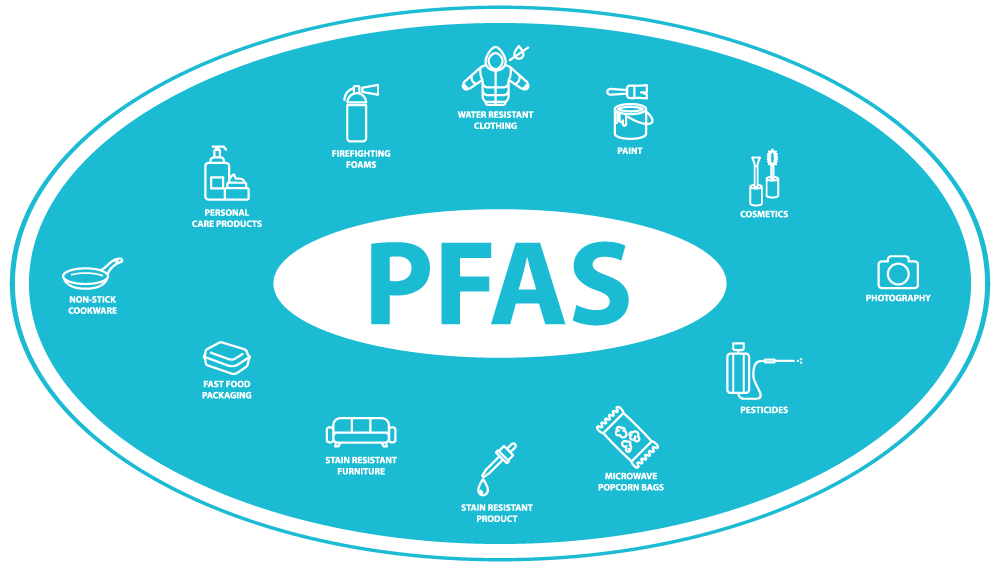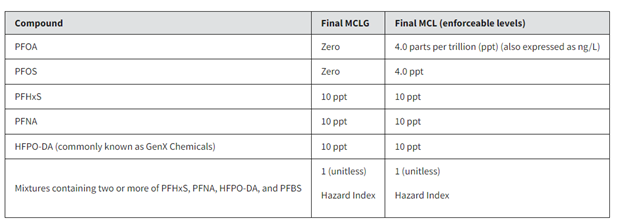
For more than 120 years, the quality of the drinking water provided by the City of Tallahassee has been exemplary. The City ensures your drinking water is safe, the highest in quality and meets all health based regulatory standards by continually monitoring our drinking water source for identified contaminants of concern as well as new contaminants identified by appropriate regulatory authorities. On June 15, 2022, the United States Environmental Protection Agency (EPA) issued new interim health advisory levels to manage the risk for a group of man-made chemicals in drinking water called PFAS (Per- and polyfluoroalkyl substances). On April 10, 2024, these interim health advisory levels were replaced by a final rule setting drinking water standards for six PFAS.
Below are the EPA's actions explained, as well as actions the City has previously undertaken and have currently planned.
What are PFAS compounds? Since the 1940s, per- and polyfluoroalkyl substances, referred to as PFAS, have been widely used in the manufacturing of carpets, clothing, fabrics for furniture, paper packaging for food, non-stick cookware, and other materials. They are also used in the formulation of fire suppressant foams and in numerous industrial processes.
Two prominent PFAS chemical compounds include:
- Perfluorooctanoic acid (PFOA). PFOA has been used to make Teflon and other similar chemicals.
- Perfluorooctane sulfonate (PFOS). PFOS has been used to make stain repellents like Scotchgard™ and fire-fighting foams.
Are PFAS still being used? Over the years, many companies have chosen to voluntarily halt the production and use of certain PFAS chemicals. In fact, most uses of PFOA and PFOS were voluntarily phased out by U.S. manufacturers in the mid-2000s. Some of these chemicals, however, are still in use for limited purposes, and these chemicals remain in the environment due to their persistence and inability to degrade.
Why are PFAS a concern? The EPA confirms that most people are exposed to these chemicals through a variety of consumer products, such as fast-food containers/wrappers, pizza boxes, personal care products, nonstick cookware, stain-resistant coatings used on carpets and upholstery, and more. Drinking water can be an additional source of exposure in communities where these chemicals have entered the water supplies. Due to their widespread use and persistence in the environment, most people all over the world have been exposed to PFAS. While research continues, scientific studies have shown that exposure to some PFAS in the environment may be linked to harmful health effects in humans and animals.
What is the EPA's new drinking water standard, and what does it mean?
- The EPA's role in establishing drinking water regulations: EPA regulates and establishes maximum contaminant levels for hundreds of compounds in drinking water. EPA developed a PFAS Strategic Roadmap in October 2021 to address potential associated health risks. As is commonly the first step in EPA developing a regulation, a health advisory level was issued in June 2022. On April 10, 2024, EPA issued its final rule setting drinking water standards for six per- and polyfluoroalkyl substances (PFAS). In order to give time for utilities around the country time to assess and implement solutions within their systems, EPA will begin enforcement of these standards in 2029. These new standards establish legally enforceable levels, called Maximum Contaminant Levels (MCLs), for six PFAS in drinking water: PFOA, PFOS, PFHxS, PFNA, and HFPO-DA as contaminants with individual MCLs and PFAS mixtures containing at least two or more of PFHxS, PFNA, HFPO-DA, and PFBS using a Hazard Index MCL to account for the combined and co-occurring levels of these PFAS in drinking water. EPA also finalized health-based, non-enforceable Maximum Contaminant Level Goals (MCLGs) for these PFAS.

- EPA's Health Advisory Level for PFAS: In 2016, the EPA issued a non-regulatory lifetime health advisory of 70 parts per trillion (ppt) for individual and combined PFOA and PFOS in drinking water. On June 15, 2022, the EPA set new Interim Health Advisory Levels for PFOA at 0.004 ppt and 0.02 ppt for PFOS. EPA's new drinking water standard replaces the previous health advisory level.

What is the City of Tallahassee doing about PFAS?
Testing: In 2014-2015, the City sampled municipal drinking water wells for PFAS under EPA's Unregulated Contaminant Monitoring Rule (UCMR). The UCMR program collects data for contaminants suspected to be present in drinking water but that do not have health-based standards set under the Safe Drinking Water Act. PFAS were not detectable in any of the samples collected at that time.
In 2019, the City collected samples from all 27 public drinking water wells for several PFAS compounds. No PFAS compounds were detected in the majority of wells. The highest level detected during the sampling event at one well was 5.9 ppt for PFOS, significantly below EPA's health advisory at the time of testing of 70 ppt.
In 2024, as part of another UCMR effort, the City sampled municipal drinking water wells for 29 PFAS. As part of this robust testing, two analytes at one well tested above the minimum reporting threshold.

Download Full UCMR5 Chart
Of the two analytes detected above the threshold at the one well, only one analyte sampled would be recognized as above the new standard that will be enforced in 2029. The City is taking proactive steps to optimize flow within its distribution system to ensure it will continue to meet health based drinking water standards.
This is why research is a priority. The City's environmental, technical, and legal professionals are actively engaged in this research, specifically by:
- Conducting additional monitoring for PFAS in the City's water supply
- Researching established and emerging testing and treatment options as they are made available
- Continuing to collaborate with other communities, industry groups, and agencies to develop practical and feasible strategies to reduce impacts of PFAS as the EPA develops and finalizes its future drinking water standards
Legal Action: In June of 2021,the City filed suit against PFAS manufacturers. The State of Florida and numerous other municipalities from across the country have also filed lawsuits. These cases are currently in active litigation regarding the impact of PFAS chemicals.
The City's Complaint alleges that the Defendants introduced PFOA and PFOS into the U.S. marketplace with full knowledge of their toxicity and propensity to contaminate groundwater. The Complaint further alleges that the Defendants failed to warn the public in general about the risks associated with PFOS and PFOA. The use and disposal of AFFF, a firefighting foam, has resulted in exceedances of FDEP's provisional cleanup target level in the soil and groundwater at the City's Fire Training Facility, formerly a part of the Dale Mabry Army Airfield in operation from 1928 to 1961. Through this Complaint, the City is proactively seeking compensation from the Defendants for reimbursement of assessment and remediation costs for the site.
Monitoring and Information Sharing: Since before 2019, City staff has been following national level discussions about PFAS. Many water utilities, industry groups, and agencies, including our environmental and technical professionals at the City of Tallahassee, are working together to learn more about PFAS and research options that can reduce PFAS levels. City staff will continue collaborating with national and state utility industry groups regarding this matter. Resources and information will be shared here, on the City's website, and will be updated as it becomes available. Links to several of those resources are provided below.
Continued Commitment: As we have for more than 120 years, the City of Tallahassee will continue to ensure the drinking water we provide our customers is safe, reliable, and of the highest quality.
We are always available to talk about how we produce and deliver your drinking water and the steps we take to maintain quality. If you have questions, please contact us (850) 891-1200 or (850) 891-1228.
Additional Resources